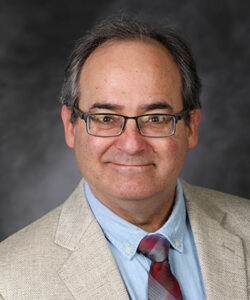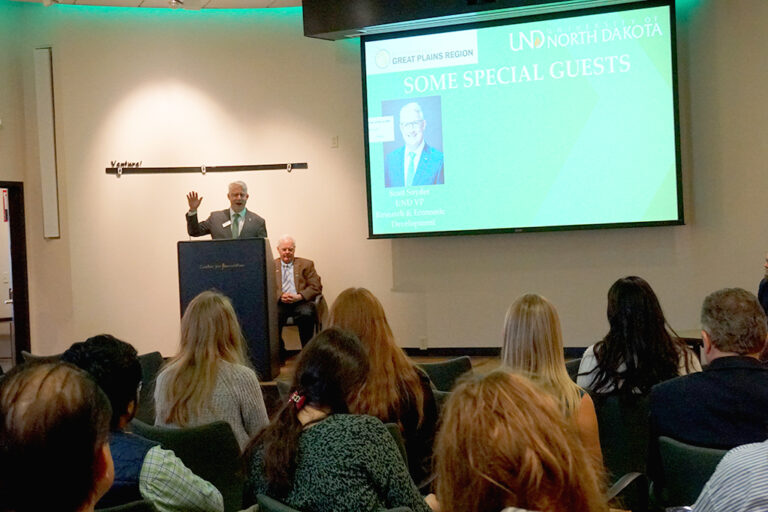Tom Vilsack, U.S. Secretary of Agriculture, keynotes UND-hosted conference
At conference for rural-health reporters, Vilsack speaks on Agriculture Department’s impact on rural health
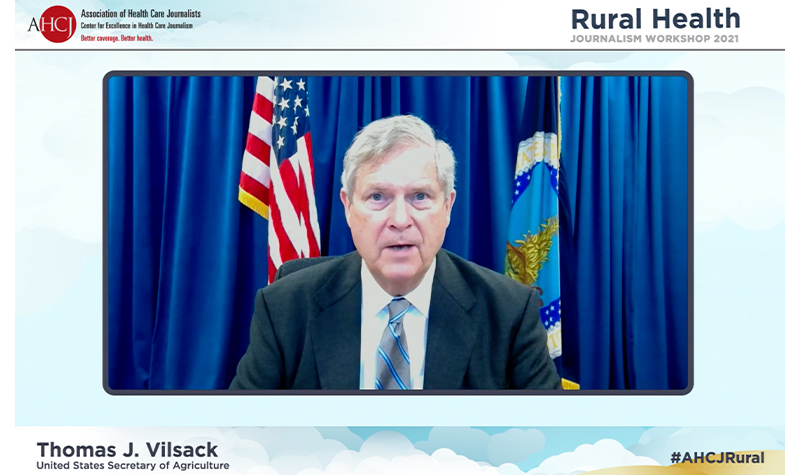
When a question arises regarding the U.S. government’s rural health-care initiatives, a reporter is likely to call the Department of Health & Human Services. That’s the official home of Medicare and Medicaid, after all.
So why was the U.S. Secretary of Agriculture addressing the national 2021 Rural Health Journalism Workshop?
Why indeed, said Agriculture Secretary Tom Vilsack, with a smile. “I must say that when I saw this on my schedule a couple of days ago, I asked myself that question,” Vilsack said.
“Then I started thinking about it, and there are a number of reasons why it’s appropriate for me to be visiting with you today.”
Vilsack was the featured speaker at the virtual conference, which was organized by the Association of Health Care Journalists and hosted by UND and the University’s Center for Rural Health. At seminars and workshops during the three-day event, speakers talked about many different aspects of rural health, steering reporters toward stories about the rural health-care workforce, small-town hospitals and aging in rural America, among other topics.
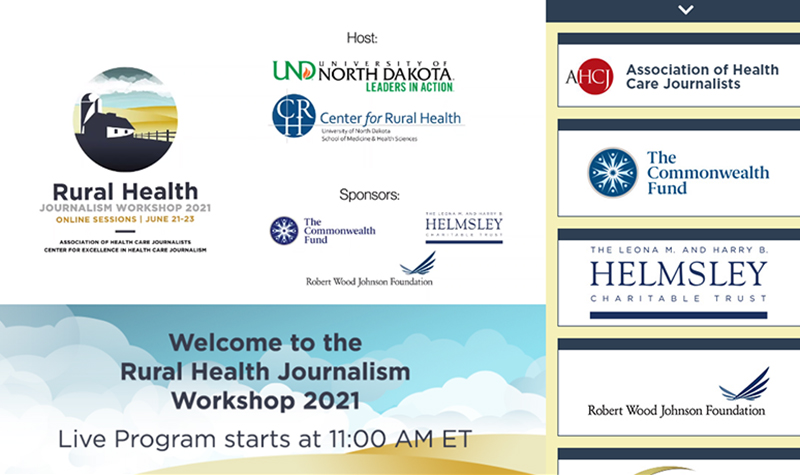
During his appearance, Vilsack spoke for about 10 minutes, describing for his audience of health reporters the Agriculture Department’s long history with and many programs addressing rural health. Then he answered questions from the virtual crowd – questions that came to him via the session’s moderator, Health Care Reporter Tony Leys of the Des Moines Register.
Before he became President Obama’s secretary of agriculture (serving from 2009 to 2017) and was reappointed to that office by President Biden earlier this year, Vilsack was governor of Iowa, Leys noted. “So I’m going to try really hard not to reflexively refer to him as Gov. Vilsack,” Leys joked. “Because when I see his face, I still think of him that way.”
There are many reasons why a reporter with a question about rural health might want to call the Agriculture Department, Vilsack said during his talk. Among them:
New hospitals, new clinics
• Through the Community Facilities Direct Loan and Grant Program, USDA is investing $185 million to improve and modernize essential services in rural areas of 32 states, Vilsack noted. And “these include four major hospital projects,” he said.
“The USDA is providing literally tens of millions of dollars of assistance to rural communities, to enable them either to construct a new hospital or equip an existing hospital or modernize facilities.”
• The American Rescue Plan Act of 2021, signed into law by President Joe Biden on March 19, also includes provisions for the USDA to help improve rural health care. Specifically, the bill authorizes $500 million in Community Facility Program funds to help rural hospitals and local communities boost access to COVID-19 vaccines & food assistance.
The funds “may also be used by these facilities to expand telemedicine or telehealth opportunities,” Vilsack said.
“This is a good opportunity as well for these rural clinics to extend a significant outreach in rural communities in terms of health care services. So, we’re excited about these opportunities that are forthcoming during the summer.”
• USDA also is supporting efforts in Congress to pass infrastructure funding, some versions of which include money for expanding broadband access.
Only about 64 percent of America has high-speed broadband access – “and the 36 percent that doesn’t is mostly located in rural areas,” he said.
So, “when we talk about health care in rural communities, we can’t talk about it without mentioning broadband,” because broadband so clearly is vital to the functioning of a modern hospital or clinic, Vilsack said.
• Then there are the USDA’s expansive nutrition duties, every element of which is intended to help improve human health, Vilsack noted.
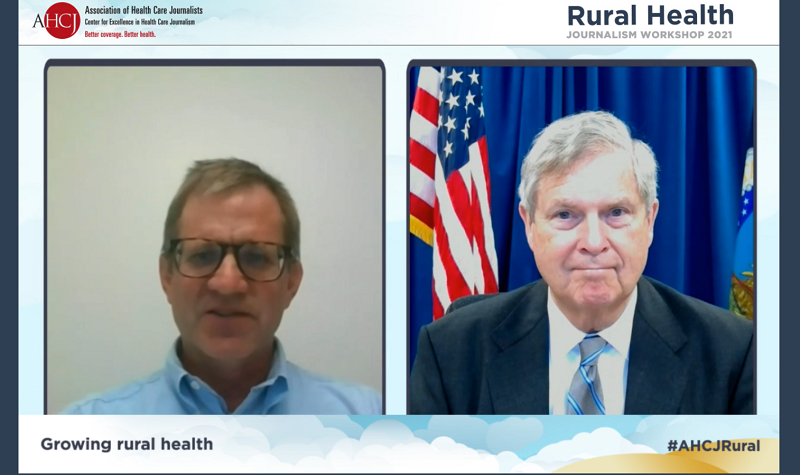
COVID safety nets
As the agency’s website declares, the U.S. Department of Agriculture “is responsible for providing a safety net for millions of Americans who are food-insecure and for developing and promoting dietary guidance based on scientific evidence.”
The COVID pandemic greatly complicated that task, by depriving low-income young people of the breakfasts and lunches they would have received at school. “Because of the lockdowns, parents incurred expenses for those breakfasts or lunches, which now had to be provided at home,” Vilsack noted.
“That’s why we created the Pandemic EBT program, which was designed to help parents who’d found themselves with children at home instead of in school during COVID.”
EBT stands for Electronic Benefits Transfer. It’s the system that lets a Supplemental Nutrition Assistance Program or SNAP participant pay for food using SNAP benefits.
“The Pandemic EBT program provides those families with additional resources to defray the cost of those meals,” Vilsack said.
“We combine that with the Summer P-EBT program, which will help parents get additional resources to be able to provide nutritious meals for their children during the summer months. …
“We know these nutrition programs make a difference in terms of health and educational outcomes,” Vilsack said.
“So this is a really significant opportunity for us to improve the health outcomes of youngsters during the summer months as well as preparing them better to learn.”
‘Change taking place’ for agriculture
After listing other efforts by the USDA to improve the health and wellness of Americans living in rural communities, Vilsack took questions from his audience. Several questioners asked about the effect of climate change on the U.S. food supply, and one listener offered this inquiry: Given that many people in agricultural areas are politically conservative, is climate change a low priority for them?
“If you had asked me that question 10 years ago, I would have answered, ‘Yes,’” Vilsack said.
“But with the extended droughts, more severe floods and more severe storms that we’ve seen, I think farmers are understanding that there is indeed a change taking place. … I think there’s an understanding that something’s going on here.”
But those same farmers shouldn’t despair, because the federal government’s goal of reducing carbon emissions very likely will include incentives for farmers to do their part, Vilsack continued.
“For example, I think we’re going to continue to see ways in which over time, we can eliminate lagoons (for the treatment of livestock waste), and instead look at the income side of manure.” This likely will include separating the water from the solids, allowing the farmer to reuse the water for the farming operation and convert the solids into fertilizer and other products.
“That, to me, is the best way to approach some of the challenges that we face,” Vilsack said. “I believe we can do so in a way that improves health, improves income, creates more jobs and provides a better quality of life in rural areas.”
All in all, when reporters want to cover rural America’s health care issues in depth, they should make sure one of their first calls goes to the USDA, Vilsack suggested. “And I do hope,” he added with a grin, “that I’ve made the case that I deserve to be here, and why it’s appropriate for me to be visiting with you today.”
